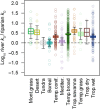Global patterns and drivers of ecosystem functioning in rivers and riparian zones
- PMID: 30662951
- PMCID: PMC6326750
- DOI: 10.1126/sciadv.aav0486
Global patterns and drivers of ecosystem functioning in rivers and riparian zones
Abstract
River ecosystems receive and process vast quantities of terrestrial organic carbon, the fate of which depends strongly on microbial activity. Variation in and controls of processing rates, however, are poorly characterized at the global scale. In response, we used a peer-sourced research network and a highly standardized carbon processing assay to conduct a global-scale field experiment in greater than 1000 river and riparian sites. We found that Earth's biomes have distinct carbon processing signatures. Slow processing is evident across latitudes, whereas rapid rates are restricted to lower latitudes. Both the mean rate and variability decline with latitude, suggesting temperature constraints toward the poles and greater roles for other environmental drivers (e.g., nutrient loading) toward the equator. These results and data set the stage for unprecedented "next-generation biomonitoring" by establishing baselines to help quantify environmental impacts to the functioning of ecosystems at a global scale.
Figures




References
-
- Galy V., Peucker-Ehrenbrink B., Eglinton T., Global carbon export from the terrestrial biosphere controlled by erosion. Nature 521, 204–207 (2015). - PubMed
-
- Tranvik L. J., Downing J. A., Cotner J. B., Loiselle S. A., Striegl R. G., Ballatore T. J., Dillon P., Finlay K., Fortino K., Knoll L. B., Kortelainen P. L., Kutser T., Larsen S., Laurion I., Leech D. M., Leigh McCallister S., McKnight D. M., Melack J. M., Overholt E., Porter J. A., Prairie Y., Renwick W. H., Roland F., Sherman B. S., Schindler D. W., Sobek S., Tremblay A., Vanni M. J., Verschoor A. M., von Wachenfeldt Eddie, Weyhenmeyer G. A., Lakes and reservoirs as regulators of carbon cycling and climate. Limnol. Oceanogr. 54, 2298–2314 (2009).
-
- Woodward G., Gessner M. O., Giller P. S., Gulis V., Hladyz S., Lecerf A., Malmqvist B., McKie B. G., Tiegs S. D., Cariss H., Dobson M., Elosegi A., Ferreira V., Graça M. A. S., Fleituch T., Lacoursière J. O., Nistorescu M., Pozo J., Risnoveanu G., Schindler M., Vadineanu A., Vought L. B.-M., Chauvet E., Continental-scale effects of nutrient pollution on stream-ecosystem functioning. Science 336, 1438–1440 (2012). - PubMed
-
- Follstad Shah J. J., Kominoski J. S., Ardón M., Dodds W. K., Gessner M. O., Griffiths N. A., Hawkins C. P., Johnson S. L., Lecerf A., LeRoy Carri J., Manning D. W. P., Rosemond A. D., Sinsabaugh R. L., Swan C. M., Webster J. R., Zeglin L. H., Global synthesis of the temperature sensitivity of leaf litter breakdown in streams and rivers. Glob. Chang. Biol. 23, 3064–3075 (2017). - PubMed
Publication types
MeSH terms
LinkOut - more resources
Full Text Sources

